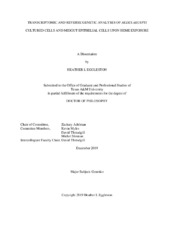| dc.description.abstract | The female mosquito Aedes aegypti requires amino acids and other nutrients like heme and iron from a blood meal to initiate vitellogenesis. Heme is a pro-oxidant molecule that acts as a nutrient, signaling molecule and in large quantities, as a toxin. Ae. aegypti has developed a few strategies to handle heme toxicity, as during a typical meal ~10mM is released into the midgut lumen. These strategies include heme aggregation to the peritrophic matrix and the degradation of heme by heme oxygenase in the cytosol of the midgut epithelium. However, despite the importance of heme as a nutrient and toxin, the mechanism of entry into the midgut epithelial cells is not currently known. As no heme transport proteins in have been identified in any dipteran, heme fluorescent analog studies were performed to visualize changes in expression caused by heme followed by global expression analyses performed in both cultured cells and midgut tissues using NGS-based RNA sequencing with the end goal to identify the gene(s) that encode the membrane bound heme import proteins responsible for heme uptake during blood digestion. A list of candidate genes for RNAi knockdown was compiled based on differential expression, expression pattern across heme treatments and number of TM domains. These genes’ function relating to heme transport was then identified through siRNA mediated knockdown and treatment with zinc mesoporphyrin to assess changes in heme uptake. A number of candidate genes were identified in 2 or more cultured cell datasets out of 4 examined. In particular, 63 candidates were identified in heme exposed midguts, 23 of which were found in at least 1 cultured cell analysis as well. However, very few highly differentially expressed genes were found in any of the analyses indicating that heme import may be controlled by a redundant system of multiple transport proteins instead of a single one. Alternatively, heme transport in Ae. aegypti could be regulated post-translationally. Knockdown of candidate genes AAEL004657 and AAEL008664 suggested a potential role in heme transport in Aag2 cultured cells, though more work is needed to localize and elucidate their specific functions. | en |


